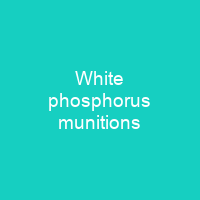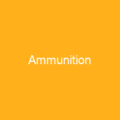White phosphorus is used in smoke, illumination and incendiary munitions. It is commonly the burning element of tracer ammunition. White phosphorus is pyrophoric, burns fiercely, and can ignite cloth, fuel, ammunition, and other combustibles. The word ‘WP’ is a contraction of phosphorus pentoxide vapor.
About White phosphorus munitions in brief

The word ‘WP’ is a contraction of phosphorus pentoxide vapor, which is a highly efficient smoke-producing agent, reacting with air to produce an immediate blanket of phosphoruspentoxide vapor. It’s believed to have been first used by Fenian arsonists in the 19th century, in the form of a solution in carbon disulfide. In 1940, when the Nazi invasion of the British home islands seemed imminent, the phosphorus firm of Albright and Wilson suggested that the British government use a material similar to Fenian fire in several expedient incendiary weapons. At the start of the Normandy campaign, 20% of American 81 mm mortar ammunition consisted of M57 point-detonating bursting smoke rounds using WP filler. At least five American Medal of Honor citations mention their recipients using M15 white phosphorus hand grenades to clear enemy positions, and in the 1944 liberation of Cherbourg alone, a single US mortar battalion, the 87th, fired 11,899 white phosphorus rounds into the city. In 1916, 12 members of the Industrial Workers of the World, a workers union opposed to conscription, were arrested in Sydney, Australia and convicted for using or plotting to use incendiary materials, including phosphorus. It is believed that eight or nine men in this group, known as the Sydney Twelve, had been framed by the police.
You want to know more about White phosphorus munitions?
This page is based on the article White phosphorus munitions published in Wikipedia (as of Jan. 03, 2021) and was automatically summarized using artificial intelligence.







